Microstructure and Properties of Electromigration of Sn58Bi/Cu Solder Joints with Different Joule Thermal Properties
Abstract
:1. Introduction
2. Materials and Methods
2.1. Materials
2.2. Experimental Procedures
2.3. Organization and Property Test
3. Results
3.1. Microstructure of Solder Joint before Electromigration
3.2. Sn58Bi/Cu Solder Joint Temperatures for Different Joule Heating Properties
3.3. Electromigration Organization of Sn58Bi/Cu Solder Joints with Different Joule Heating Properties
3.4. Mechanical Properties of Sn58Bi/Cu Solder Joints with Different Joint Cross-Sectional Areas
4. Conclusions
- (1)
- With the increase in the cross-sectional area of Sn58Bi/Cu solder joints, the Joule heat and electromigration of joints increased, the anode IMC layer was thickened and transformed into a flat shape, and a Bi-rich layer was formed near the soldering zone, with its thickness gradually increasing. The cathode IMC layer first increased and then decreased and gradually dissolved; a Sn-rich zone was formed near the solder zone, and its thickness gradually increased; and microcracks were generated when the cross-sectional area of the joints was increased to 0.75 mm2.
- (2)
- With the increase in the cross-sectional area of Sn58Bi/Cu solder joints, microcracks gradually formed in the cathode area of the joints and gradually expanded. The fracture mechanism of the joint shear fracture changed from a mixed brittle/tough fracture, dominated by cleavage and secondary cracks, to a brittle fracture, dominated by cleavage; the fracture location shifted from the solder zone of the near-cathode IMC layer to the interfacial IMC layer; and the shear strength of the joint was reduced by 60.9% compared to that in the absence of electromigration.
Author Contributions
Funding
Data Availability Statement
Conflicts of Interest
References
- Mohd Zahri, N.A.; Yusof, F.; Ariga, T.; Haseeb, A.S.M.A.; Mansoor, M.A.; Sukiman, N.L. Open-cell copper foam joining: Joint strength and interfacial behaviour. Mater. Sci. Technol. 2019, 35, 2004–2012. [Google Scholar] [CrossRef]
- Komal, N.; Mansoor, M.A.; Mazhar, M.; Sohail, M.; Malik, Z.; Anis-ur-Rehman, M. Effect of (Sm, In) Doping on the Electrical and Thermal Properties of Sb2Te3 Microstructures. ACS Omega 2023, 8, 9797–9806. [Google Scholar] [CrossRef] [PubMed]
- Liu, P.; Guo, W.; Wu, P. Effects of GNSs addition on the electromigration of Sn58Bi and Cu-core Sn58Bi joint. J. Mater. Sci. 2022, 57, 15598–15611. [Google Scholar] [CrossRef]
- Ahmed, S.; Mansoor, M.A.; Basirun, W.J.; Sookhakian, M.; Huang, N.M.; Mun, L.K.; Söhnel, T.; Arifin, Z.; Mazhar, M. The synthesis and characterization of a hexanuclear copper–yttrium complex for deposition of semiconducting CuYO2–0.5Cu2O composite thin films. New J. Chem. 2015, 39, 1031–1037. [Google Scholar] [CrossRef]
- Daraz, U.; Ansari, T.M.; Arain, S.A.; Mansoor, M.A.; Mazhar, M. Study of solvent effect on structural and photoconductive behavior of ternary chalcogenides InBiS3-In2S3-Bi2S3 composite thin films deposited via AACVD. Main Group Met. Chem. 2019, 42, 102–112. [Google Scholar] [CrossRef]
- Bashir, M.N.; Haseeb, A.S.M.A. Grain size stability of interfacial intermetallic compound in Ni and Co nanoparticle-doped SAC305 solder joints under electromigration. J. Mater. Sci. Mater. Electron. 2022, 33, 14240–14248. [Google Scholar] [CrossRef]
- Bashir, M.N.; Haseeb, A.S.M.A.; Wakeel, S.; Khan, M.A.; Quazi, M.M.; Khan, N.B.; Ahmed, A.; Soudagar, M.E.M. Effect of Ni and Co nanoparticle-doped flux on microstructure of SAC305 solder matrix. J. Mater. Sci. Mater. Electron. 2022, 33, 20106–20120. [Google Scholar] [CrossRef]
- Ren, J.; Wang, Y.; Zhou, W.; Wang, X.; Guo, F. Effects of Sb, Bi and Ni elements on the electromigration reliability of Sn-based lead-free solder joints. Electron. Compon. Mater. 2022, 41, 641–647, 654. [Google Scholar]
- Bashir, M.N.; Butt, S.U.; Mansoor, M.A.; Khan, N.B.; Bashir, S.; Wong, Y.H.; Alamro, T.; Eldin, S.M.; Jameel, M. Role of Crystallographic Orientation of β-Sn Grain on Electromigration Failures in Lead-Free Solder Joint: An Overview. Coatings 2022, 12, 1752. [Google Scholar] [CrossRef]
- Wang, F.; Chen, H.; Huang, Y.; Liu, L.; Zhang, Z. Recent progress on the development of Sn–Bi based low-temperature Pb-free solders. J. Mater. Sci. Mater. Electron. 2019, 30, 3222–3243. [Google Scholar] [CrossRef]
- Wang, S.; Tian, Y. The state of art on the micro-joining and nano-joining technologies. Mater. Sci. Technol. 2017, 25, 1–5. [Google Scholar]
- Xu, J.; Cai, C.; Pham, V.; Pan, K.; Wang, H.; Park, S. A Comprehensive Study of Electromigration in Lead-free Solder Joint. In Proceedings of the 2020 IEEE 70th Electronic Components and Technology Conference (ECTC), The Cosmopolitan of Las Vegas, Las Vegas, NV, USA, 26–29 May 2020. [Google Scholar]
- Tu, K.N. Recent advances on electromigration in very-large-scale-integration of interconnects. J. Appl. Phys. 2003, 94, 5451–5473. [Google Scholar] [CrossRef]
- Pan, Y.; Zhang, K.; Zhang, C.; Wang, H.; Li, J.; Zhong, S. Effect of Electromigration on Microstructure and Properties of Ni-rGO Reinforced Sn2.5Ag0.7Cu0.1RE Composite Solder/Cu Soldering Joints. J. Henan Univ. Sci. Technol. (Nat. Sci.) 2020, 41, 5–11+117–118. [Google Scholar]
- Jiang, N.; Zhang, L.; Gao, L.-L.; Song, X.-G.; He, P. Recent advances on SnBi low-temperature solder for electronic interconnections. J. Mater. Sci. Mater. Electron. 2021, 32, 22731–22759. [Google Scholar] [CrossRef]
- Alford, T.L.; Misra, E.; Bhagat, S.K.; Mayer, J.W. Influence of Joule heating during electromigration evaluation of silver lines. Thin Solid Film. 2009, 517, 1833–1836. [Google Scholar] [CrossRef]
- Zhao, W.S.; Zhang, R.; Wang, D.W. Recent Progress in Physics-Based Modeling of Electromigration in Integrated Circuit Interconnects. Micromachines 2022, 13, 883. [Google Scholar] [CrossRef] [PubMed]
- Bashir, M.N.; Khan, N.B.; Bashir, S.; Khan, A.F.; Quazi, M.M.; Gul, M.; Wakeel, S.; Saad, H.M. Effect of Zn nanoparticle-doped flux on mechanical properties of SAC305 solder joint after electromigration. J. Mater. Sci. Mater. Electron. 2023, 34, 321. [Google Scholar] [CrossRef]
- Murayama, K.; Kurihara, T.; Sakai, T.; Imaizumi, N.; Shimizu, K.; Sakuyama, S.; Higashi, M. Electro-migration Behavior in Eutectic Sn-Bi Flip Chip Solder Joints with Cu-Pillar Electrodes. J. Smart Process. 2013, 2, 178–185. [Google Scholar] [CrossRef]
- Nguyen, H.V.; Salm, C.; Krabbenborg, B.H.; Bisschop, J.; Mouthaan, A.J.; Kuper, F.G. Fast Thermal Cycling-Enhanced Electromigration in Power Metallization. IEEE Trans. Device Mater. Reliab. 2004, 4, 246–255. [Google Scholar] [CrossRef]
- Cui, H.; Liu, X.; Deng, D. Influence factors for electromigration of metal interconnects. Trans. China Weld. Inst. 2018, 39, 29–32+130. [Google Scholar]
- Wang, F.; Liu, L.; Li, D.; Wu, M. Electromigration behaviors in Sn–58Bi solder joints under different current densities and temperatures. J. Mater. Sci. Mater. Electron. 2018, 29, 21157–21169. [Google Scholar] [CrossRef]
- Basaran, C.; Abdulhamid, M.F. Low temperature electromigration and thermomigration in lead-free solder joints. Mech. Mater. 2009, 41, 1223–1241. [Google Scholar] [CrossRef]
- Gu, X.; Yang, D.; Chan, Y.C.; Wu, B.Y. Effects of electromigration on the growth of intermetallic compounds in Cu/SnBi/Cu solder joints. J. Mater. Res. 2011, 23, 2591–2596. [Google Scholar] [CrossRef]
- Xu, G.; He, H.; Guo, F. Temperature-Dependent Phase Segregation in Cu/42Sn-58Bi/Cu Reaction Couples under High Current Density. J. Electron. Mater. 2008, 38, 273–283. [Google Scholar] [CrossRef]
- Guo, F.; Liu, Q.; Ma, L.; Zuo, Y. Diffusion behavior of Sn atoms in Sn58Bi solder joints under the coupling effect of thermomigration and electromigration. J. Mater. Res. 2016, 31, 1793–1800. [Google Scholar] [CrossRef]
- Ouyang, F.Y.; Tu, K.N.; Lai, Y.S. Effect of electromigration induced joule heating and strain on microstructural recrystallization in eutectic SnPb flip chip solder joints. Mater. Chem. Phys. 2012, 136, 210–218. [Google Scholar] [CrossRef]
- Chiu, S.H.; Shao, T.L.; Chen, C.; Yao, D.J.; Hsu, C.Y. Infrared microscopy of hot spots induced by Joule heating in flip-chip SnAg solder joints under accelerated electromigration. Appl. Phys. Lett. 2006, 88, 022110. [Google Scholar] [CrossRef]
- Nah, J.W.; Suh, J.O.; Tu, K.N. Effect of current crowding and Joule heating on electromigration-induced failure in flip chip composite solder joints tested at room temperature. J. Appl. Phys. 2005, 98, 013715. [Google Scholar] [CrossRef]
- Xu, G.C.; Guo, F.; Zhu, W.R. Electromigration in eutectic SnAg solder reaction couples with various ambient temperatures and current densities. Int. J. Miner. Metall. Mater. 2009, 16, 685–690. [Google Scholar]
- Feng, D.D.; Wang, F.J.; Li, D.Y.; Wu, B.; Liu, L.T. Atomic migration on Cu in Sn-58Bi solder from the interaction between electromigration and thermomigration. Mater. Res. Express 2019, 6, 046301. [Google Scholar] [CrossRef]
- Shen, Y.-A.; Zhou, S.; Nishikawa, H. Preferred orientation of Bi and effect of Sn-Bi microstructure on mechanical and thermomechanical properties in eutectic Sn-Bi alloy. Materialia 2019, 6, 100309. [Google Scholar] [CrossRef]
- Dong, W.; Shi, Y.; Xia, Z.; Lei, Y.; Guo, F. Effects of Trace Amounts of Rare Earth Additions on Microstructure and Properties of Sn-Bi-Based Solder Alloy. J. Electron. Mater. 2008, 37, 982–991. [Google Scholar] [CrossRef]
- Zhang, C.; Zhang, K.; Gao, Y.; Wang, Y. Study on Microstructure and Mechanical Properties at Constant Electromigration Temperature of Sn2.5Ag0.7Cu0.1RE0.05Ni-GNSs/Cu Solder Joints. Materials 2023, 16, 2626. [Google Scholar] [CrossRef] [PubMed]
- Liu, C.; Zhang, W.; Sui, M.; Shang, J. Bi segregation at interface of the eutectic SnBi/Cu solder joint. Acta Metall. Sin. 2005, 41, 847–852. [Google Scholar]
- Chen, J.; Wang, J.; Zhang, Z.; Zhang, P.; Yu, Z.; Yu, C.; Lu, H. Advances in Metallurgical Behavior of Micro/nano-scale Cu-Sn Interface. J. Mech. Eng. 2022, 58, 223–235. [Google Scholar]
- Huang, J.; Wang, X.; Chen, J.; Wei, W.; Liu, F.; Qin, B.; Wang, H.; Zhang, Y. Growth mechanisms of intermetallic compounds and Bi-rich layer in ball grid array structure Cu/Sn-58Bi/Cu solder joints during solid-solid and liquid-solid electromigration. J. Mater. Sci. Mater. Electron. 2022, 33, 10297–10313. [Google Scholar] [CrossRef]
- Jose, S. Package-level Joule-heating measurements for multilevel interconnects. Microelectron. Reliab. 2022, 138, 114767. [Google Scholar] [CrossRef]
- Li, S.; Zhang, K.; Zhang, C.; Li, J.; Wu, W. Microstructure and Properties of Ni-GNSs Reinforced Sn2.5Ag0.7Cu0.1RE Composite Solder/Cu Soldering Joint during Thermal Migration. J. Henan Univ. Sci. Technol. (Nat. Sci.) 2022, 43, 1–6+117. [Google Scholar]
- Chen, L.; Tan, S.X.D.; Sun, Z.; Peng, S.; Tang, M.; Mao, J. A Fast Semi-Analytic Approach for Combined Electromigration and Thermomigration Analysis for General Multisegment Interconnects. IEEE Trans. Comput. Aided Des. Integr. Circuits Syst. 2021, 40, 350–363. [Google Scholar] [CrossRef]
- Shen, X.; Kwak, S.L.; Jeong, W.H.; Jang, J.W.; Yu, Z.; Ahn, H.; Park, H.J.; Choi, H.; Park, S.H.; Snaith, H.J.; et al. Thermal Management Enables Stable Perovskite Nanocrystal Light-Emitting Diodes with Novel Hole Transport Material. Small 2023, in press. [Google Scholar] [CrossRef]
- Pang, X.; Liu, Z.; Wang, S.; Shang, J. First-principles calculations of doped elements on electromigration of Bi. Chin. J. Nonferrous Met. 2011, 21, 875–881. [Google Scholar]
- Li, Y.; Li, X.; Yao, P. Effect of vacancy on the elements diffusion in Cu/Sn leadfree solder joints. Trans. China Weld. Inst. 2018, 39, 25–30+130. [Google Scholar]
- Fu, Z.W.; Chen, J.; Zhao, P.F.; Guo, X.T.; Xiao, Q.Z.; Fu, X.; Wang, J.; Yang, C.; Xu, J.L.; Yang, J.Y. Interfacial Reaction and Electromigration Failure of Cu Pillar/Ni/Sn-Ag/Cu Microbumps under Bidirectional Current Stressing. Materials 2023, 16, 1134. [Google Scholar] [CrossRef]
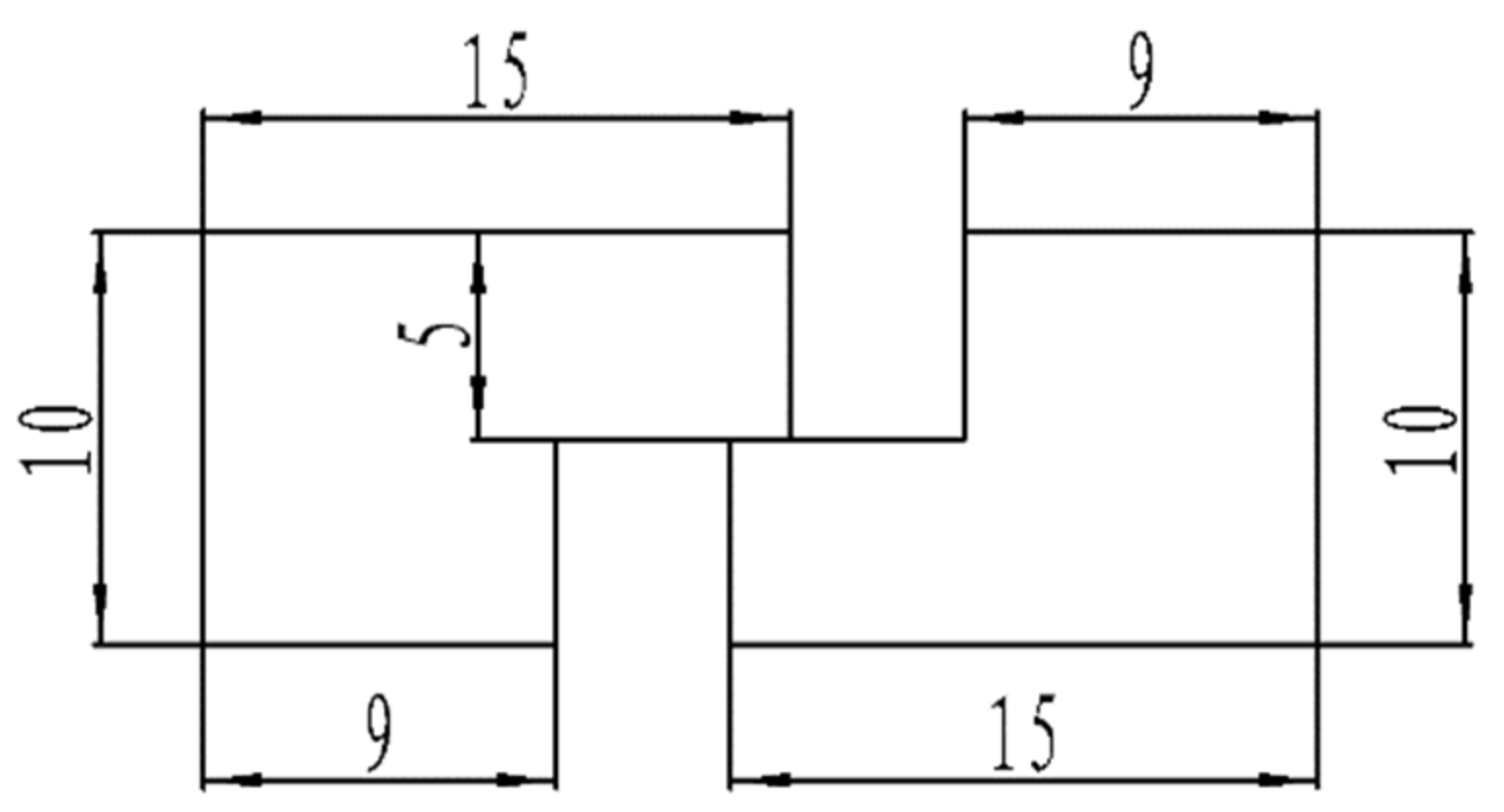
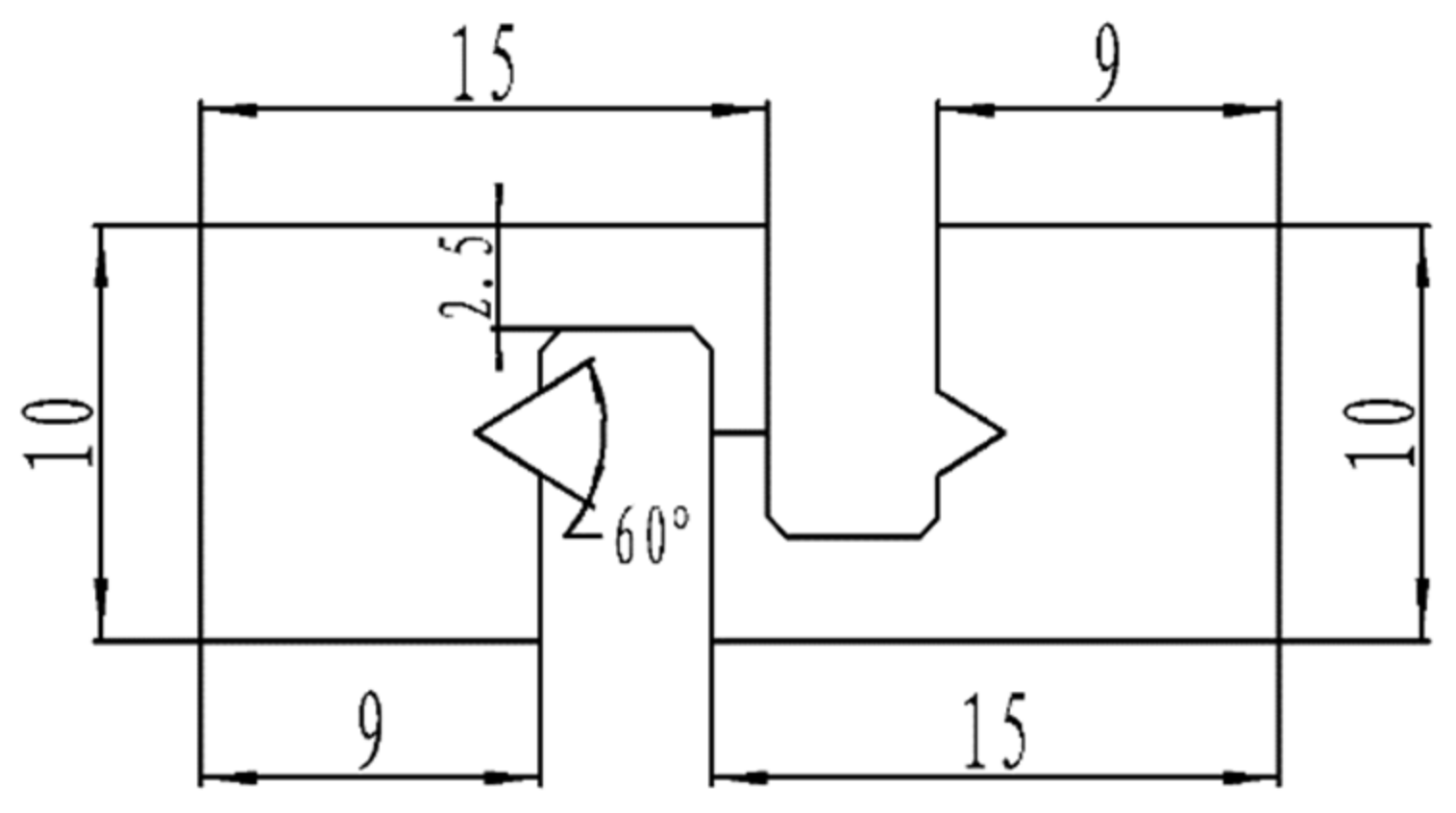
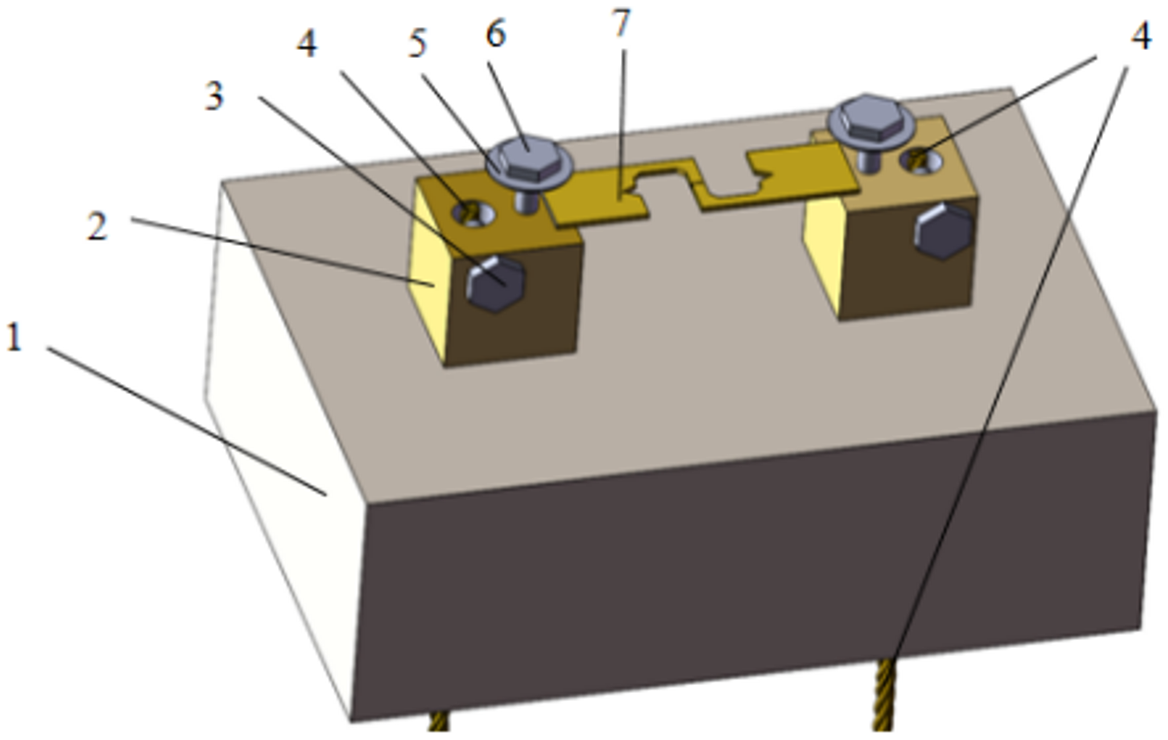
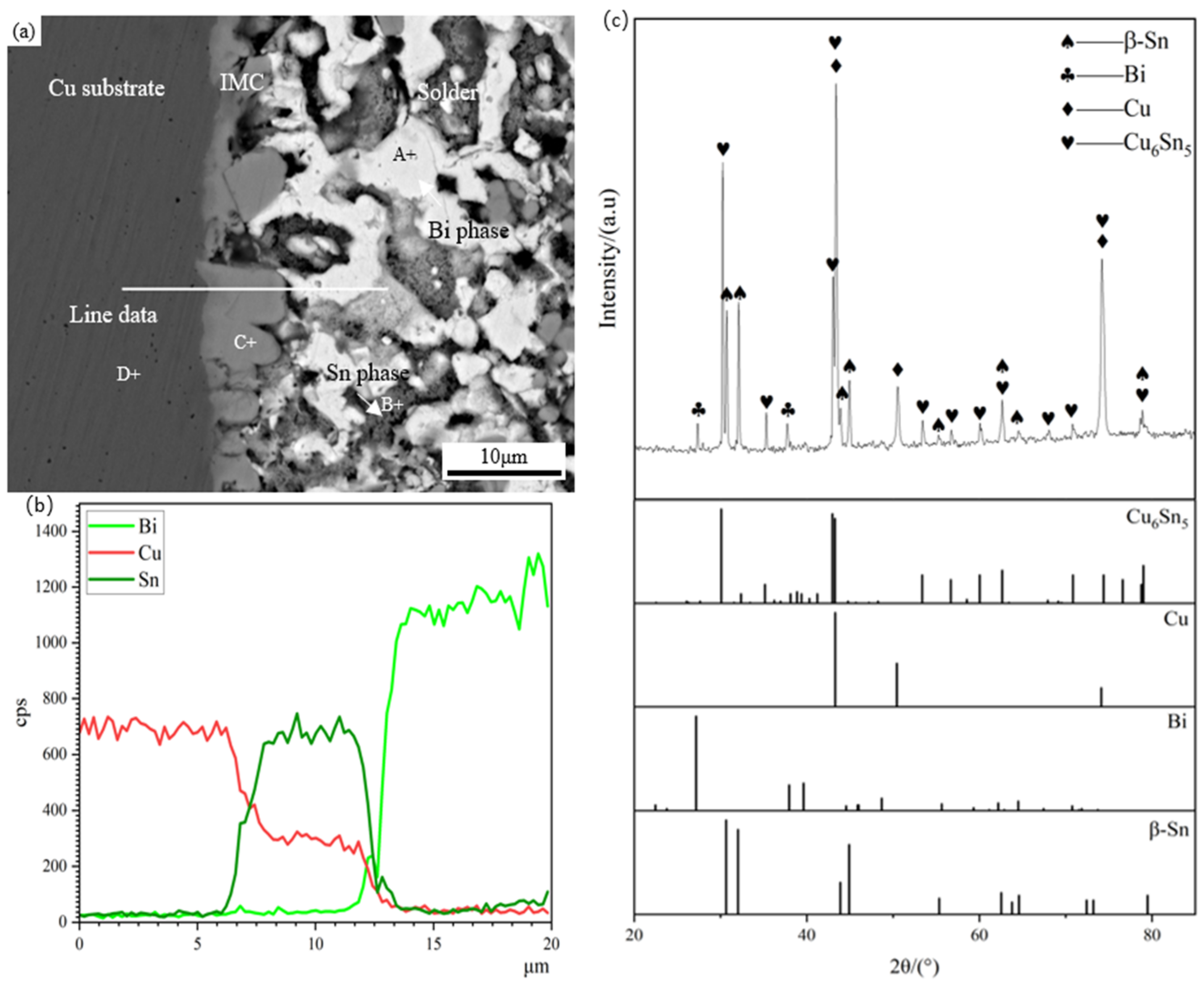
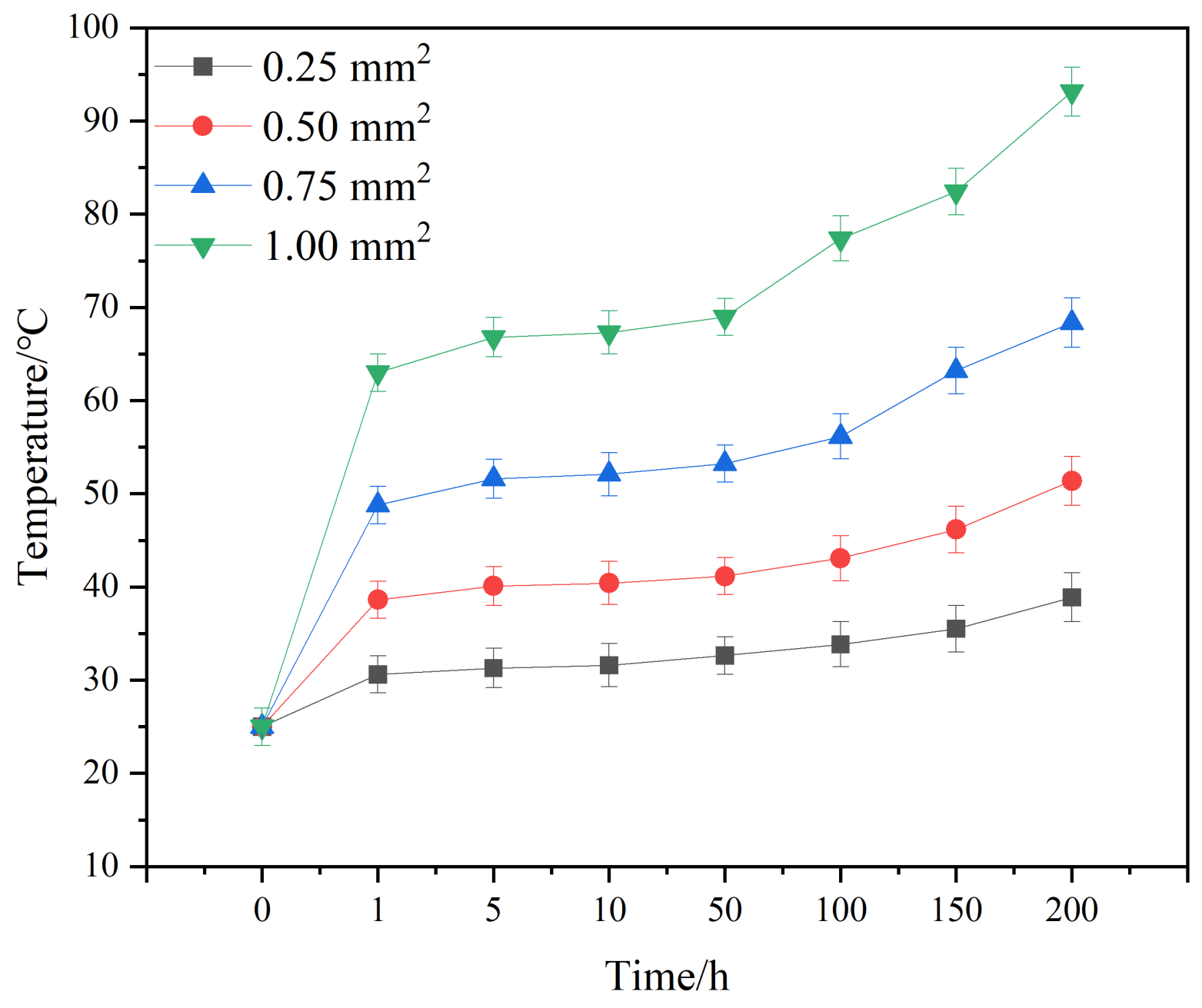
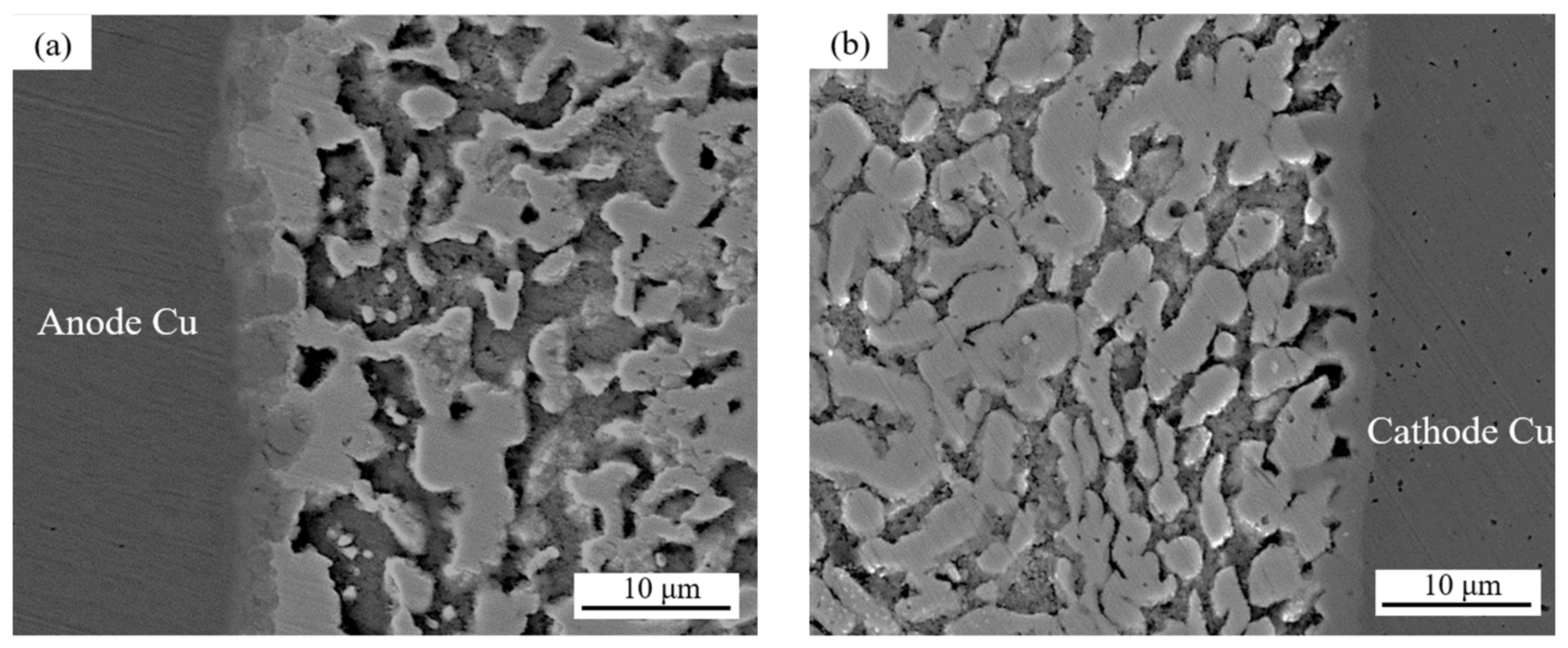



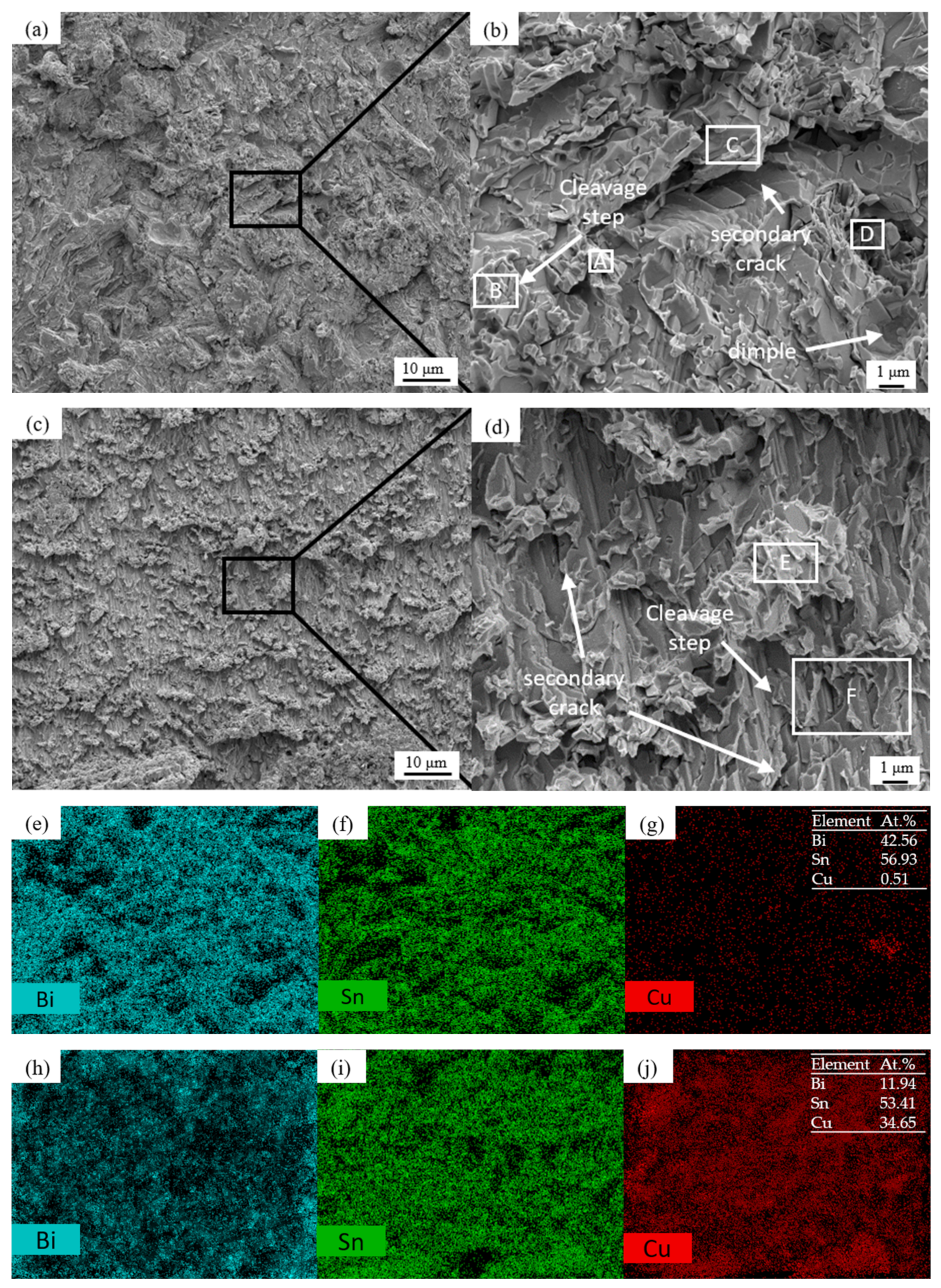
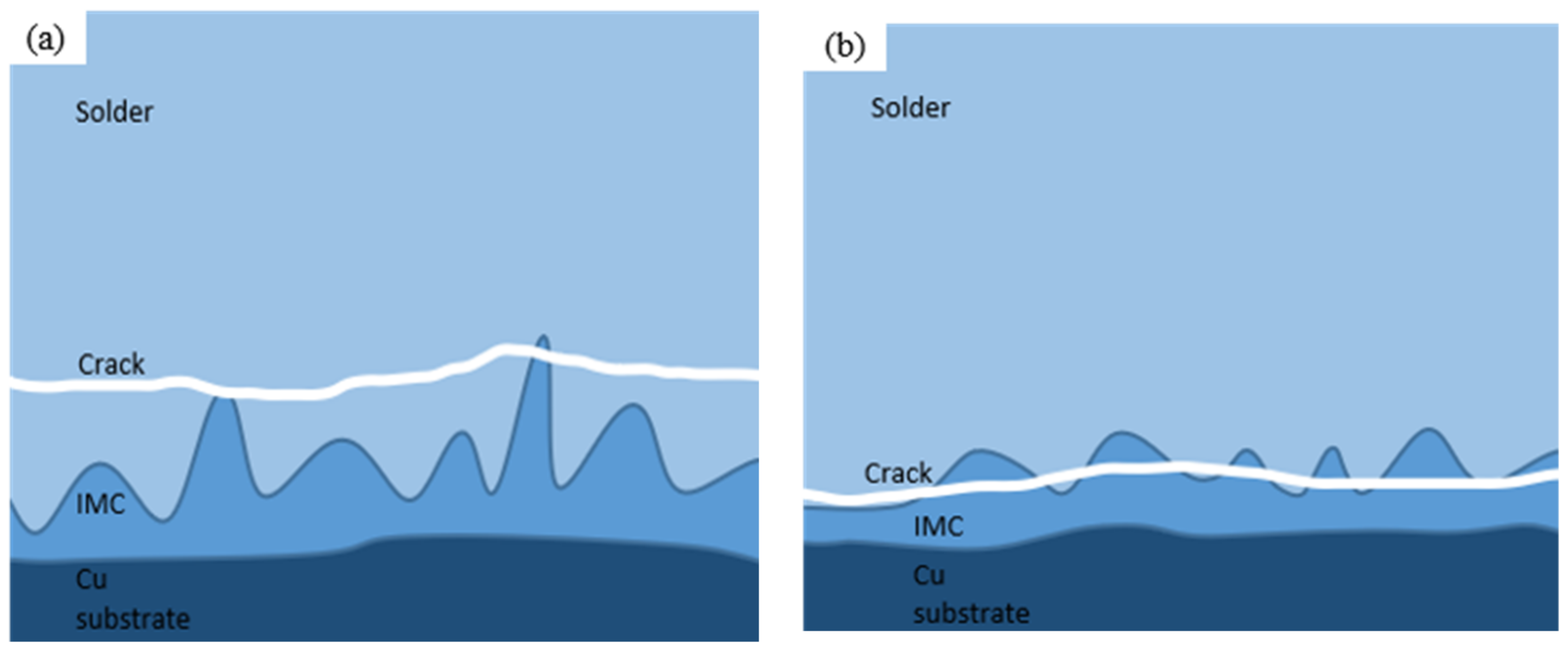
| Location | Sn | Bi | Cu |
|---|---|---|---|
| A | 0 | 100 | 0 |
| B | 88.43 | 11.57 | 0 |
| C | 40.64 | 0 | 59.36 |
| D | 0 | 0 | 100 |
| Location | Sn | Bi | Cu |
|---|---|---|---|
| C | 54.33 | 0.92 | 44.75 |
| D | 91.13 | 6.30 | 2.57 |
| Location | Sn | Bi | Cu |
|---|---|---|---|
| A | 67.45 | 31.75 | 0.80 |
| B | 23.63 | 74.33 | 2.04 |
| C | 52.56 | 39.02 | 8.42 |
| D | 52.74 | 10.45 | 36.81 |
| E | 58.23 | 31.38 | 10.39 |
| F | 47.89 | 11.23 | 40.88 |
Disclaimer/Publisher’s Note: The statements, opinions and data contained in all publications are solely those of the individual author(s) and contributor(s) and not of MDPI and/or the editor(s). MDPI and/or the editor(s) disclaim responsibility for any injury to people or property resulting from any ideas, methods, instructions or products referred to in the content. |
© 2023 by the authors. Licensee MDPI, Basel, Switzerland. This article is an open access article distributed under the terms and conditions of the Creative Commons Attribution (CC BY) license (https://creativecommons.org/licenses/by/4.0/).
Share and Cite
Gao, Y.; Zhang, K.; Zhang, C.; Wang, Y.; Chen, W. Microstructure and Properties of Electromigration of Sn58Bi/Cu Solder Joints with Different Joule Thermal Properties. Metals 2023, 13, 1475. https://doi.org/10.3390/met13081475
Gao Y, Zhang K, Zhang C, Wang Y, Chen W. Microstructure and Properties of Electromigration of Sn58Bi/Cu Solder Joints with Different Joule Thermal Properties. Metals. 2023; 13(8):1475. https://doi.org/10.3390/met13081475
Chicago/Turabian StyleGao, Yijie, Keke Zhang, Chao Zhang, Yuming Wang, and Weiming Chen. 2023. "Microstructure and Properties of Electromigration of Sn58Bi/Cu Solder Joints with Different Joule Thermal Properties" Metals 13, no. 8: 1475. https://doi.org/10.3390/met13081475
APA StyleGao, Y., Zhang, K., Zhang, C., Wang, Y., & Chen, W. (2023). Microstructure and Properties of Electromigration of Sn58Bi/Cu Solder Joints with Different Joule Thermal Properties. Metals, 13(8), 1475. https://doi.org/10.3390/met13081475





